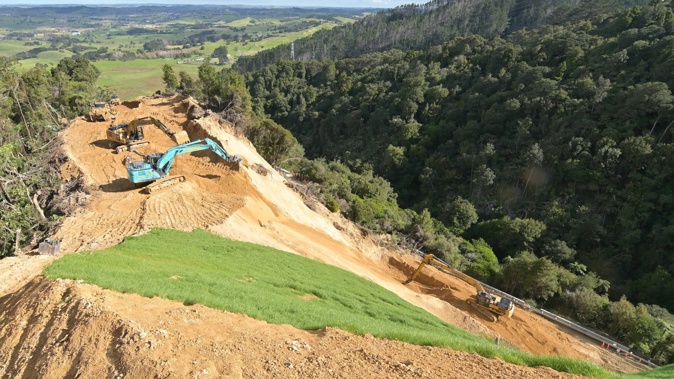
A swathe of super-slippery soil that could not be accessed earlier came down in a big slip in the Brynderwyn Hills, investigators say.
Road crews are labouring to reopen State Highway 1 south of Whangārei after two slips in late April put the job back weeks.
A new independent geotech report said the combination of soils and rock that gave way was so unusually slippery, the area was in a “critical state of stability”.
“These soils were located on the steep vegetated natural face above the road which was largely inaccessible for safely mapping or investigating the ground,” it said in the report, released on Thursday.
Waka Kotahi told RNZ it applied an “observational approach” instead.
This was “often applied for the stability of road construction works in areas of complex geology and where the amount of geotechnical data from drilling and mapping is limited by access (and time)”, it said.
Roadworkers then cut into the toe of the slope, and were installing soil nails - but that was not enough. Early warning signs of a slip allowed the workers to clear out.
Video captured by the workers caught the first signs of major movement.
“It is also clear from the video, and observing the material involved in the slip, that this area of the slope was in a critical state of stability, where any disturbance was highly likely to trigger movement,” the report by engineering firm Tonkin and Taylor said.
Transport Minister Simeon Brown.
The weight of all the slipped soil might have impacted the stability of the road it landed on, and that would need monitoring, it said.
Some geotechnical work and terrain evaluation had gone on near the spot, but the road crews “hit a very localised section of soil which was completely unique in itself to the geology”, Waka Kotahi said.
“It was unlike any other soil composition that was found within the closure site.”
The report confirmed engineers had not found any other areas of such slippery soils, “but this should be reconfirmed as part of the risk review and works completion procedures”.
The report suggested the project was not yet out of the woods and recommended investigating for any further “uncemented” soils that could present a wider risk.
It also noted a number of “major geological features” that should be further assessed.
Waka Kotahi said the observational approach taken in February was one that let it balance the need to get a thorough understanding of the geology with urgency to get work done in the drier months.
The report laid out how the area was now being stabilised, with diggers removing dirt at the crest of the collapsed slope, then working their way down excavating some or all the residual soil as they went.
“We consider this would be a safe approach,” the engineers said.
 An active slip brought down a substantial amount of earth and trees at the Brynderwyns site.
An active slip brought down a substantial amount of earth and trees at the Brynderwyns site.
The highly weathered rock underneath meant that once the soil was gone “we expect the slope should achieve adequate global stability”.
Without the recovery work going on now, the road would likely have to be closed for six to eight times briefly, and once for a long time, each year, it said.
“These recovery works will significantly enhance the level of service of the road and prevent these long duration closures.”
- Phil Pennington, RNZ
Take your Radio, Podcasts and Music with you









